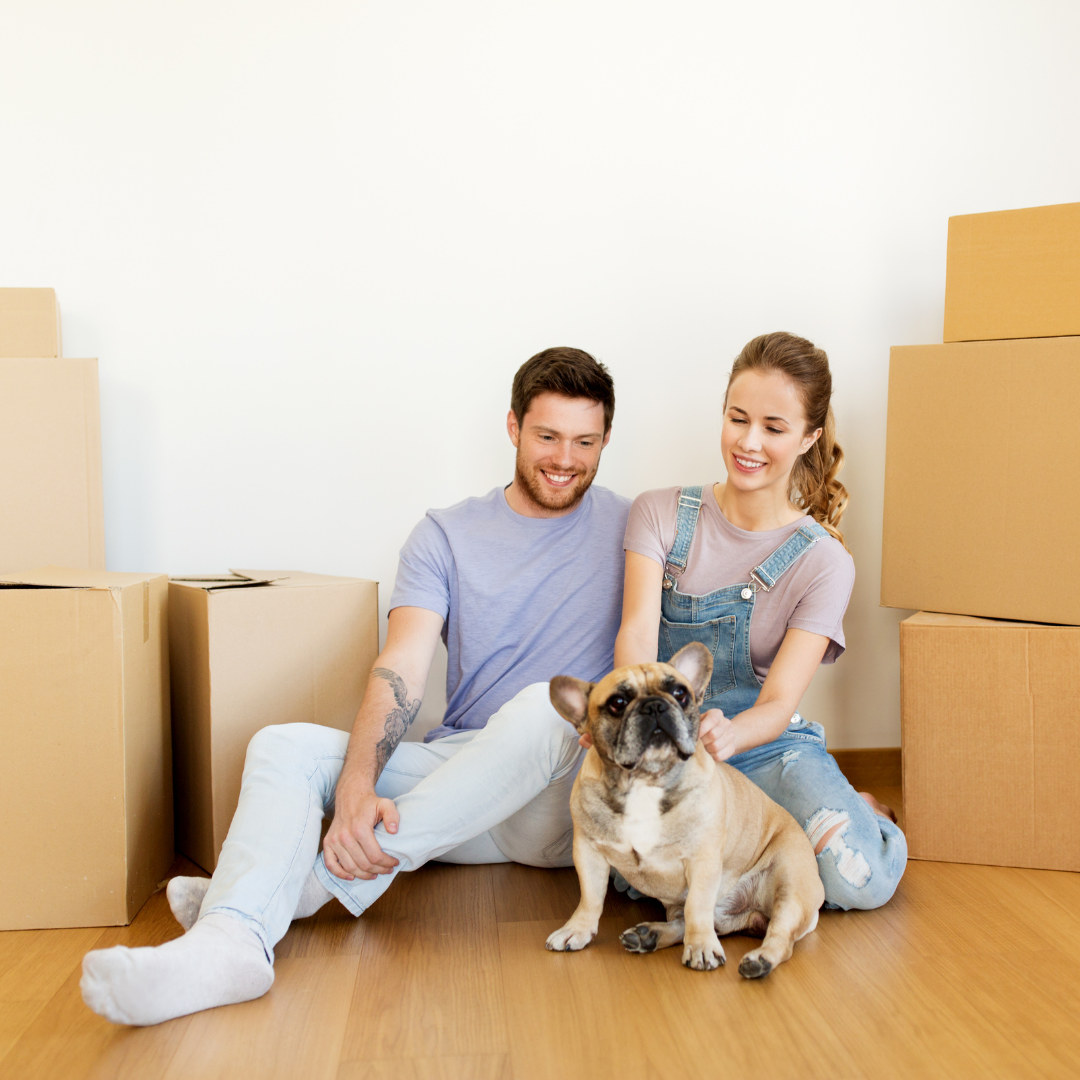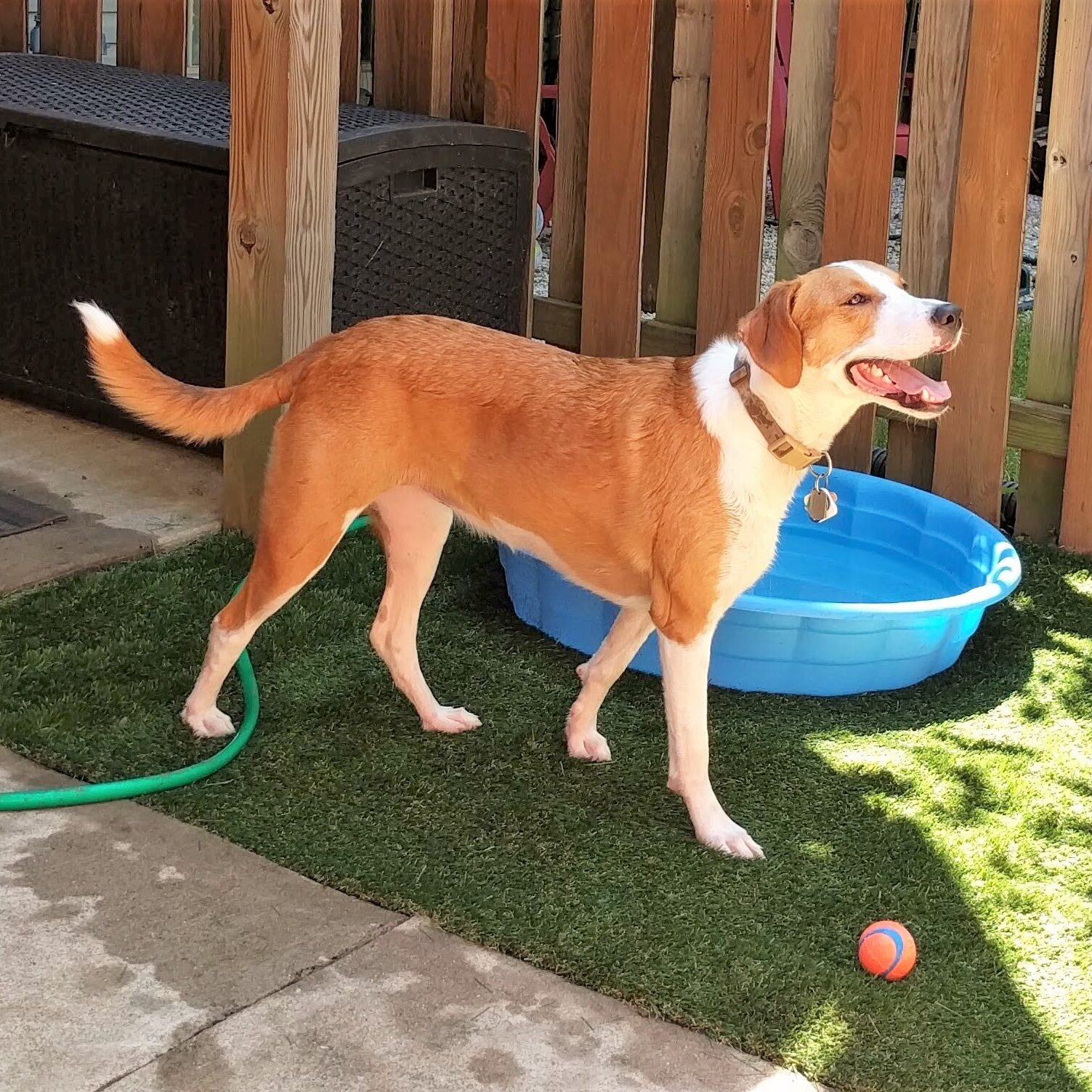Up until a couple years ago, neither of us had planned to become professional dog…
7 Tips To Make Moving With Your Dog Less Stressful

Whether you’re moving across town or across the country, the process will impact your dog’s behavior and stress levels from start to finish. Their environment keeps changing as things get packed, their people are busy and unavailable, routines start to fall apart, and the commotion cuts into their beauty sleep. Then, they have to deal with the trip to the new home and the adjustment period that follows.
In this article, I provide 7 ways you can make moving with a dog – from packing the first box, to moving day, to settling into the new home – more successful and low-stress for everyone.
TIP #1: Before you start packing, designate a bin for your dog’s daily essentials.
I’ve moved 5+ times in the last decade alone, so I’ve developed a pretty good system to keep things organized. But as moving day approaches, the system inevitably disintegrates into “throw anything you see in a bin”. At that point, most of the unpacked things are your everyday essentials like a toothbrush, favorite sneakers, or laptop. They usually get thrown in a random bin or are moved out of their usual place and you can’t find them.
To get ahead of this, I now set out a carry-on suitcase early in the packing process. This becomes the designated home for anything I use often and would hate to be without. It then also serves as my “overnight” bag.
You can do the exact same thing for your dog! Get a large clear bin and label it with your dog’s name. When your dog’s essentials are not in use, this bin can be their resting place. Think about items like their food & water bowls, walking equipment, a few days’ worth of food in a storage container, chews and treats, a couple of their favorite toys, medications and supplements, etc.
For larger items like a dog bed, you can keep the bin right next to their bed so it doesn’t get misplaced. On moving day, just make sure everything is packed in the bin and then put it somewhere in your car or on the truck that is easily accessible.
TIP #2: Make a plan for where your dog will be on moving day.
On moving day, doors are left open, strangers may be coming in and out, your dog’s favorite things are not in the same place, and the routine is totally off. To keep your dog from getting stressed out or lost, I highly recommend sending them away for the day.
If your family and friends aren’t built for helping you move, this is an area where they can really help out. Ask them to take your dog for a day or two while things are crazy. If you don’t have that option, you might also consider having them go to doggy daycare or a boarding facility. You could also have your dog hang out in the new home for the day while the current home is being packed up.
TIP #3: Maintain your dog’s routine as much as possible throughout the process.
While some aspects of your dog’s daily routine won’t be feasible, try to keep the critical elements on schedule. It can be easy to get lost in packing and forget to address your dog’s basic needs.
To get ahead of this, set alarms for your dog’s mealtimes or when they need to take medication. After feeding them, check and refill their water bowl if needed. When you go to the bathroom, use that as a reminder to let your dog go to the bathroom too. If your dog really loves their daily walk or playtime, consider hiring a dog walker or asking friends/family to help out.
TIP #4: Lean on enrichment to keep your dog entertained and relaxed.
The moment you start packing, you’ll have less time and energy to spend on your dog, such as playing with them, cuddling on the couch, or going for walks. Since these enriching aspects of their daily life are temporarily lessened, you can compensate by prepping some enrichment activities that your dog can enjoy on their own:
- Purchase a bag of digestible chews and keep it near your dog’s designated “bin”.
- Fill several silicone toys with some dry and wet foods and put them in the freezer.
- Scatter your dog’s kibble or some treats in a fenced yard or snufflemat to give your dog a scavenger hunt.
Also, my dog loves to have a front row seat when I’m deep in a task like packing or putting together new furniture. While I appreciate his expert supervision and desire to be near me, this quickly becomes annoying. If that sounds like your dog, I recommend moving their bed near where you’ll be working and giving them something yummy to chew or lick. This will help them stay out of your way and prime them to settle down for a nice nap when they’re finished.
If your dog will be spending moving day with someone else, definitely send them with some of these enrichment activities. This will help your dog pass the time and giving your helper some downtime as well.
TIP #5: Make the drive to the new home comfy and fun.
Once you are ready to transport your dog to their new home, it can help to have some comfort items in the car. I like to put my dog’s bed and a favorite toy in the car so they can sleep on the drive, especially if this will be a trip lasting longer than 30 minutes.
Remember – your dog is uncertain what is going on and have none of the same information that you do. Simple things like this can help their world feel a little more predictable. It also wouldn’t hurt to stop for a nice treat along the way, like a pup cup.
If your drive to the new home will a few hours or more, be prepared for stops every 2 hours or so. For people, this is already recommended to prevent blood clots. For your dog, it will be nice to give them a potty break and get some sniff time in. You can even plan to rent a Sniffspot along your route so you dog can really stretch their legs, play, and decompress.
If your trip requires an overnight stay, you’ll need to find dog-friendly accommodations. However, hotels can be very unsettling for many dogs because they aren’t used to hearing strangers walking through the hall outside your room. Instead, I recommend staying at an Air BnB so your dog has a space that more resembles home.
TIP #6: Be prepared for a relapse in your dog’s understanding of previously trained cues.
When you train your dog, they are learning a new concept AND paying attention to what’s happening in the environment. This means they have more trouble generalizing their knowledge than we do. As you move to a new home, they may appear less reliable when you ask for a behavior or like they are just ignoring you.
For this reason, it’s a good idea to do some remedial training in the new environment. For example, you may want to teach them that waiting at doors applies to these new doors as well. If your dog had a designated “place” in the old home, set up their place in a similar area of the house and give them a few practice sessions to relearn that skill.
TIP #7: Take advantage of the new environment by preventing unwanted behaviors.
The flipside of dog’s having trouble generalizing their learning, is that a new home presents a unique opportunity to hit reset on many unwanted habits. If your dog had a tendency in your old home to dash out a door, bark out the window, or shred toilet paper, use this brief window to get ahead of them! Immediately set up management strategies to prevent your dog from rehearing old habit in this new space.
Also, it’s not uncommon to see new behaviors (e.g., barking at the fence, surfing kitchen counters) emerge from your dog. When you first arrive, let your dog be curious and explore the new space. The first time you notice them perform a behavior you’d rather not live with, snap into prevention mode to nip that habit in the bud.


